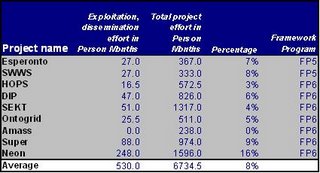
This week we celebrated the final review of the DIP project (http://dip.semanticweb.org/), which stands for Data, Information, and Process Integration with Semantic Web Services. DIP is a 16 MEuro, 3 year project partially funded by the European Commission, involving about 20 top class industrial and academic partners, including SAP, BT, iSOCO, Unicorn (IBM), Hanival, OU, EPFL, FZI, etc.). DIP finishes on December 31, 2006.
During the final review of two days, 40 members of the consortium presented the results to three external experts hired by the EC, and to the EC Project Officer. Wonderful new technology has been developed that has the potential to change businesses in the future. In the context of this blog, I am especially interested in what happens with all this technology once the project has finished. Of the two day review, almost half a day was dedicated to exploitation plans, which in itself is a positive exception. Exploitation plans lay out the realistic intentions of the consortium to use (apply, commercialize) project results beyond the scope of the project.
The highlights of the exploitation session included:
- Many different kind of commercial exploitation plans
- Firm commitment to create a new company
- Acquisition of DIP partner by large IT company
- Vertical exploitation of case studies in particular sectors
- Horizontal exploitation through acquisition of DIP partner
- Joint exploitation plans for large organizations and SMEs
- All licensing for core technology is Open Source
- Academic exploitation through take up in many recent R&D projects
- Strong influence on standards in two leading standards bodies
In three or five years we will see how many of the exploitation plans have become reality.
Needless to say, that the review was a big success (flagship project, an example).
There is also a movie available explaining the value of the project in terms of three particular sectors, e-government, telco, and e-banking. I will make the movie later available on this blog.
